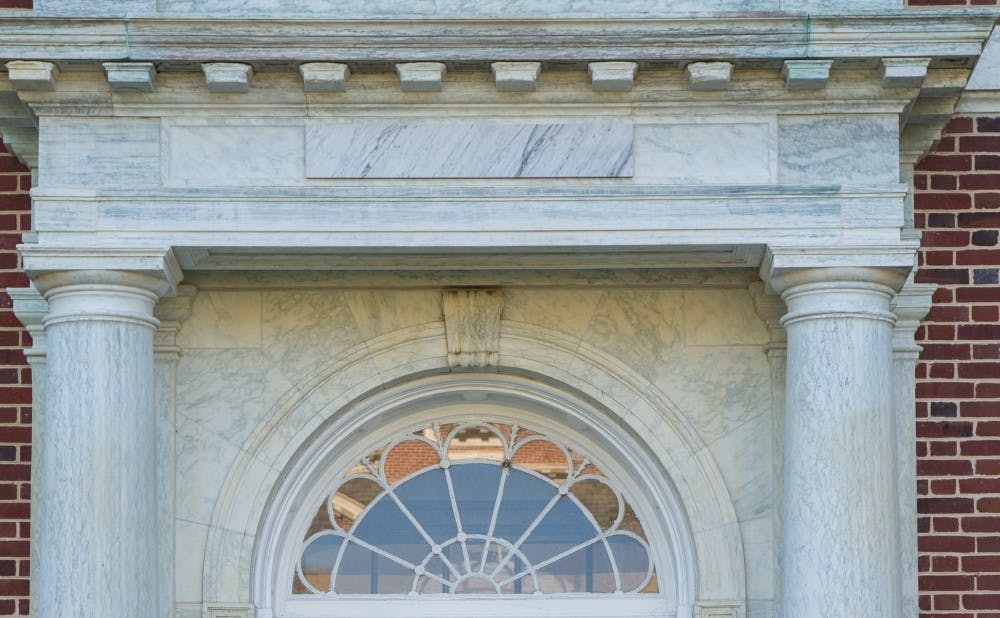Have you ever wondered how Crowell Quad got its name? Or why Classroom Building is just called the “Classroom Building?”
To answer these questions, we need to look back almost 200 years and track the University's evolution from the Union Institute Academy, to Trinity College, to what we now call Duke University. The history of Duke lives within its buildings and the names that they carry.
West Campus quads
Craven Quad has a story that dates back to before Duke itself.
In 1838, a small preparatory school opened in Randolph County for the young men of the area. This school was called the Union Institute Academy, and Braxton Craven was its principal beginning in 1842, then its president. Craven Quad was constructed in 1930 in remembrance of him, a quad that many love for its proximity to the Brodhead Center and the bus stop.
During Craven’s tenure, he oversaw the transition of the institute from a small preparatory school to Trinity College. But the intentions of this college are where present-day Duke and what was formerly called the Cherokee Industrial School at Trinity College diverge. Craven established this Trinity boarding school as an attempt to westernize Indigenous students, specifically from the eastern band of the Cherokee nation.
Braxton Craven resigned from his post in 1864, and just a few years later another familiar name took up the mantle: John F. Crowell. During Crowell’s time as president from 1887 to 1894, he oversaw Trinity College’s movement from Randolph County to Durham. This move was with the intention of Crowell’s vision of increased urbanization as a means to bolster the popularity of the college. Today, Crowell Quad, which was designed in 1930, honors Crowell’s presidency.
When students walk directly across the quad from the entrance to Craven they will find themselves in Kilgo Quad. Designed in 1930 by the architerical firm of Horace Trumbauer, this quad is dedicated to former Trinity President John Carlisle Kilgo.
Kilgo was known for his involvement in the 1903 Bassett Affair, where he intended to resign from the presidency if his colleague, John Spencer Bassett, was dismissed. State democratic leaders and press considered Bassett a threat to the accepted “southern way of life” because he praised Booker T. Washington and invited him to speak on campus in 1896. However, after a vote by the Trinity College Board of Trustees, Bassett was not dismissed, and Bassett Residence Hall on East Campus was later named after him.
All of these buildings wouldn’t exist if it weren’t for the era of William Preston Few, who is today commemorated by Few Quad. Few is the only Duke and Trinity College president to have led both institutions. He served as the president of Trinity College from 1910-1924 and then of Duke University from 1924-1940. This change was ushered in by the new Duke Endowment, created in 1924 by the Duke family. It was through this endowment, which provided Few with greater financial resources, that the architecture of Duke’s campus as it exists today came to be.
The architectural firm of Horace Trumbaeur
One of the Duke Endowment’s first purchases was a contract with the office of Horace Trumbauer — the architect behind Duke’s gothic West Campus buildings — to build many of the quads that students have today.
The office of Horace Trumbaeur was hired in 1924 to design most of what is now Duke’s East and West Campuses. The head designers of this project were Horace Trumbaeur himself, William O. Frank and Julian Abele. Abele, now the namesake of Abele Quad, was one of the only renowned Black architects of his time and was the first Black graduate of University of Pennsylvania’s School of Design.
Brown Residence Hall and Frank C. Brown
Upon boarding the C1 at the West Campus bus stop, students travel to East Campus, constructed predominantly by the office of Horace Trumbaeur and originally serving as The Woman’s College at Duke.
Merely a few steps north of Marketplace is a dorm commemorating another member of the University’s construction team, Frank C. Brown. Brown can be credited for many of the ideas that led to Duke’s architecture today, overseeing the initial construction of West Campus and the renovation of East Campus.
At the time, Brown was a professor of English at Trinity College. Later, he became the first comptroller and liaison for all those involved with the construction of the new University. In this role, Brown traveled all across the country, touring colleges for architectural inspiration. Throughout his journey, he compiled travel diaries of his visits and sent letters of inspiration to the Trumbauer firm. Some of the schools he visited included Boston University, Bryn Mawr College, the University of Chicago, Harvard University and Haverford College.
“The owl gate in Rockefeller Hall is attractive and it should be remembered,” wrote Brown in his synopsis about Bryn Mawr College.
Other notes and summaries within the 201-page construction-inspiration letter commented on the amenities of dormitories and appearances of library buildings, chapels and other architectural specificities.
Name changes on East Campus
In addition to the construction history shared between West Residence Hall, Classroom Building and East Residence Hall on East Campus under Brown, there have been controversies about who these buildings are named after.
The overly literal name of “Classroom Building” for the stately building just off the East Campus bus loop only arose recently as an interim label. Up until 2018, it was named after the tobacco magnate Julian Carr, who helped acquire the Durham land that constitutes East Campus.
Carr was an outspoken politician who made statements advocating for white supremacy in vulgar manners. His name was stripped from the building after several successful student-and-professor protest efforts that began with a protest at an alumni reunion and ended with a signed petition by the Duke history department.
In a similar pattern of events, promptly after West Residence Hall’s initial construction in 1912, its name was changed to "Jarvis” to honor North Carolina’s former governor Thomas Jordan Jarvis. This name didn’t last, as it was revealed that Jarvis was a prominent white supremacist with ties to the 1898 Wilmington Insurrection. In 2020, current Duke President Vincent Price oversaw the request to the Board of Trustees that called for the name to be changed back to its original title.
The name East Residence Hall is also a recent change that arose in 2014. This building was formerly called Aycock Hall, in remembrance of former North Carolina governor Charles B. Aycock. This name was removed due to his involvement in the white supremacist movement.
Many students today still don’t know the history of the dorms they live in, nor do they remember hearing about building name changes.
“To be honest, I don’t remember much in the way of an official announcement. Even today, I still usually refer to it as Jarvis,” junior Josh Kramer said.
Further research
The stories behind Duke’s buildings and how they were named are numerous and vast. The Duke Library archives holds the key to all this information.
According to Ani Karagianis, research services library for University Archives, the University Archives possesses 11,000 linear feet of records regarding Duke history. Information is contained in papers, pamphlets, photos and digital records.
“The University Archives collects and preserves aspects of Duke history, from administrative Presidential files, to student group files, and everything in between,” Karagianis said.
To explore archival material such as Brown’s construction letters, students and community members can access any folder within the library archives tailored specifically for the simplification of research, some of which are linked in this article.
Get The Chronicle straight to your inbox
Signup for our weekly newsletter. Cancel at any time.

Audrey Patterson is a Trinity sophomore and local and national news editor of The Chronicle's 119th volume.

